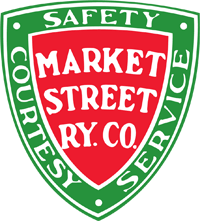At the site of today’s Green Division, crafts workers from the old Market Street Railway Company hand-built some 250 streetcars from 1923 to 1933. Car No. 798 is the only one left.
These home-built streetcars emerged at the rate of two per month from the Market Street Railway’s Elkton Shops at Ocean and San Jose Avenues (now Muni’s Curtis E. Green Light Rail Division). No. 798’s “birthday” was April 7, 1924. These streetcars were used all over the city on the lines of Market Street Railway, which was then Muni’s privately owned competitor. No. 798 itself appears to have been assigned to the car house at 24th & Utah Streets, and photographs show it serving such lines as the 19-Polk, the 35-Howard, and the 11-Mission & 24th St.
Market Street Railway began converting some of its streetcar lines to bus service in 1939-1940, including most of the lines assigned to the 24th & Utah car barn, which itself was converted to a bus garage. No. 798 went over to Muni when the two merged in 1944, officially retired, and then, on July 5, 1946 and sold for scrap. All other cars of this class were ultimately destroyed, but the body of No. 798 first became an office on Geneva Avenue, then later was moved to Columbia, in the Sierra Nevada foothills, where it ultimately became a jewelry store.
When the body was threatened with destruction in 1984, it was saved through private donations and presented to Muni, which subsequently invested more than $300,000 to have the body restored at a Tracy prison.
But Muni didn’t complete the remainder of the restoration, and No. 798 started to deteriorate at Geneva Division. Market Street Railway volunteers have restored the body again and is working with Muni to identify funding to complete the mechanical and electrical restoration of the car.
An important historical footnote: this Market Street Railway streetcar class was the type on which its first female African-American conductor (later poet and author) Maya Angelou, worked during World War II. From her account of this pioneering job she held as a teenager in I Know Why the Caged Bird Sings, she most likely worked the 5-McAllister line. Given that this is the only survivor of that streetcar class, Market Street Railway is advocating that when restoration of this streetcar is finished and it returns to active service, that it be dedicated to Ms. Angelou.
1924
Built by Market Street Railway crafts workers at Elkton Shops (now Green Division); operated mostly on 19-Polk and 11-line on Mission & 24th Street in Noe Valley.
1946
Retired by Muni (after being acquired with the Market Street Railway Company in 1944) and sold; body ultimately moved to Columbia, California, becoming a jewelry store.
1984
Threatened with destruction, car No. 798 body acquired for Muni through private donations arranged by volunteer Trolley Festival project manager Rick Laubscher, moved by Hetch Hetchy crews to San Francisco.
1989
Following prep work by Market Street Railway volunteers, No. 798 moved to Deuel Vocational Institute in Tracy for body restoration by prisoners; Muni paid $300,000 for this contract but did not complete the car on its return, leaving it to the elements in Geneva Yard.
2001
Deteriorating from neglect, Market Street Railway asked for the car to be moved to their Pharr Restoration Facility at Market & Duboce, where volunteers restored damaged portions of the body and installed seats and interiors.
2018
After ongoing advocacy, Market Street Railway wins Muni agreement to include this streetcar in its next restoration contract, expected to go out for bids in early 2019.
 Built For
Built ForMarket Street Railway Company, San Francisco CA, 1924
Builder
Market Street Railway Elkton Shops, San Francisco
Seats
50
Weight
39,895 lbs.
Length
47′ 0″
Width
8′ 9″
Height
12′ 2″
Motors
Replacement motors to be acquired; originally 4 GE 1000
Control
Replacement controllers to be acquired; originally was K 12
Trucks
Peckham 14 G3, acquired by Market Street Railway 2018 for this car
Brakes
Air
